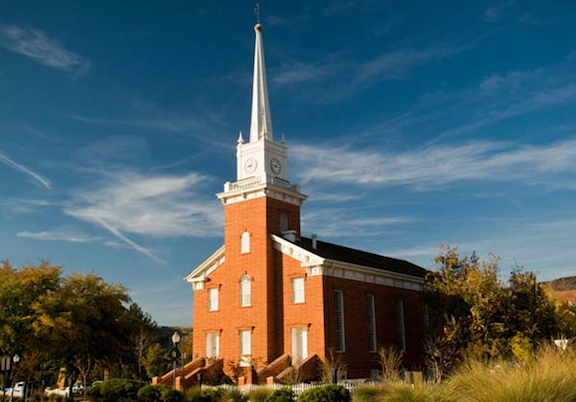St. George Tabernacle
The The Church of Jesus Christ of Latter-day Saints began setting up experimental farms in the St. George Valley in 1857–1858. In October 1861, Church leaders called 309 families to establish the Cotton Mission. Growing cotton was never fully successful, and the settlers found the conditions difficult to live in. Yet, in 1863, Church president Brigham Young directed the Saints to build a tabernacle. Funded mostly by tithing contributions, the building was completed in 1875.
The colonial, New England–type building is located on the southwest corner of Main Street. The 106-feet long and 56-feet wide structure was designed by Miles Romney with Church architect William H. Folsom consulting on the project. Romney was the master builder in charge of architecture and wood work for the tabernacle. He designed and built the circular staircases. The ground was dedicated by Orson Pratt on June 1, 1863.
Limestone for the three-foot thick basement walls was hand quarried and hauled from the foothills northeast of the city. Atop the basement walls, red sandstone boulders were quarried and cut into stones to form the two-and-a-half-thick walls. Wood trusses were cut in Pine Valley and hand-hewn. The building has twin hand-carved spiral staircases. The interior plaster of Paris ceiling and cornice work were prepared locally. The clock that adorned the exterior steeple was made in London and shipped via New York. (An electric clock was installed in 1964.) All materials were produced locally except for the window panes, door locks, hinges, and chandeliers.
Window glass was shipped from the Atlantic seaboard by way of Cape Horn to Wilmington, California, Peter Nielson paid the $600 freight bill from funds he had saved to improve his small adobe home. (See “As Doves to Our Windows,” by Elder Jeffrey R. Holland.[1])
President Brigham Young presided over the dedication on May 14, 1876. In May 1971, it was placed on the National Register of Historic Places.
The building has gone through two restorations, one in 1993 and one in 2016. Other changes and upgrades have been made throughout its history. After the 2018 completion of the restoration, the St. George Tabernacle became a public building for groups of all denominations.
- In 1878 a sacrament set and organ were added. A new pipe organ was installed in 1951.
- The building was lighted with kerosene lamps that were let down from the high ceiling by pulley to clean and trim the wicks. Later they were converted to gas. The now-electric chandeliers are still moved with pulleys.
- Two huge pot-bellied stoves heated the main floor and the stove pipes that reached through the high roof heated the balcony. Steam heat was added in the middle 1930s. Air conditioning was added later.
- Restrooms were located outside, which helped accommodate the visitors who came and stayed for two days on the Tabernacle grounds during conferences. Restrooms were installed in the 1930s.
- The building was originally protected from grazing animals by a picket fence.
- Bench seating in the balcony was replaced with individual seats from the Salt Lake Temple.
The Church film “Windows of Heaven” was filmed in part in the St. George Tabernacle.
